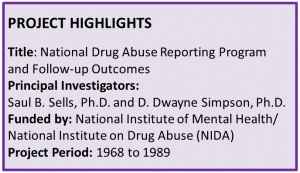National Drug Abuse Reporting Program and Follow-up Outcomes

This longitudinal project was based on the Drug Abuse Reporting Program (DARP), the first national evaluation effort of community-based treatment agencies. The original data system consisted of approximately 44,000 admissions to 52 federally-supported treatment agencies from 1969 to 1973. The study population included clients from the major treatment modalities: methadone maintenance, therapeutic community, outpatient drug free, and detoxification, as well as a comparison intake only group. Earlier treatment evaluation phases of this 20-year project helped establish that treatment works and that the longer clients stay in treatment, the better they function afterwards.
To study long-term addiction careers, a sample of daily opioid (primarily heroin) users admitted to treatment at 18 different DARP agencies throughout the United States in 1969-1972 was followed up 6 years later, and again at 12 years. Eighty percent of the 12-year follow-up sample were located and personal interviews were completed with 490 respondents.
It was found that improvements in behavioral functioning occurred throughout the first 6-year posttreatment follow-up period. These improvements stabilized between Years 6 and 12, and only about one-fourth of the sample was still addicted to daily opioid use in Year 12. At that time, pretreatment sociodemographic and background measures, as well as type of DARP treatment, were no longer related to drug use, crime, employment, and other behavioral outcomes. Length of addiction (defined as the time between first and last daily opioid use) ranged from 1 to 34 years, and on average, subjects had been in treatment on six different occasions in the past. Half of the total sample was addicted 9.5 years or longer, yet 59% never had a period of continuous daily use that exceeded 2 years. Only 27% reported continuous addiction periods that lasted more than 3 years.
Three-fourths of the addicts studied had previously experienced at least one relapse to daily opioid use after temporary abstinence. Among those who had ever temporarily quit daily opioid use at least once, 85% had done so while in a drug abuse treatment program, 78% had quit while in jail or prison, 69% had temporarily quit on their own (without treatment), and 41% had quit while in a hospital for medical treatment.
The most frequent reasons cited for quitting addiction involved psychological and emotional coping problems. Ex-addicts reported they had “become tired of the hustle” (rated as being important by 83% of the sample) and needing a change after “hitting bottom” (80%). Other reasons cited as being important were “personal or special events” such as a marriage or the death of a friend (64%), fear of being sent to jail (56%), and the need to meet family responsibilities (54%).
Altogether, the various phases of this research program spanned 20 years and resulted in over 100 papers in books, journals, and monographs.
Selected Publications
Simpson, D. D., Chatham, L. R., & Brown, B. S. (1995). The role of evaluation research in drug abuse policy. Current Directions in Psychological Science: A Journal of the American Psychological Society, 4(4), 123-126. [Abstract]
Simpson, D. D. (1993). Drug treatment evaluation research in the United States. Psychology of Addictive Behaviors, 7(2), 120-128. [Abstract]
Simpson, D. D., & Sells, S. B. (Eds.). (1990). Opioid addiction and treatment: A 12-year follow-up. Malabar, FL: Krieger Publishing Co.
Simpson, D. D., & Sells, S. B. (1982). Effectiveness of treatment for drug use: An overview of the DARP research program. Advances in Alcohol and Substance Abuse, 2(1), 7-29.
Sells, S. B., & Simpson, D. D. (Eds.). (1976). The effectiveness of drug abuse treatment: Vols. 3-5. Cambridge, MA: Ballinger.